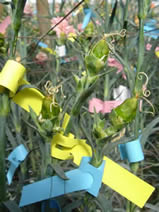

| |
|
|
|
|
|
|
The traditional methods of genetic improvement based on breeding and selection The use of Mutagenesis in the genetic improvement |
Table n. 1 |
|||||
| About the plant | productivity | growth speed | uniformity of production | stem rigidity | |
| plant height | presence of lateral buds | Fusarium resistance | summer or winter cultivation | ||
| About the leaves | consistence | dimension | color | ||
| About sepals | number | shape | consistence | color | |
| About petals | shape | dimension | kind of edge | number | |
| consistence | low temperature resistance | ||||
| About flower | shape | dimension | vase life | color | |
| creation of new colors | way of flowering | seasonal changes of color | |||
| About trade | resistance to transport | resistance to manipolation | resistance to conservation | ||
Effectively, the first step in a breeding program is the choice of the characteristics to work with and it depends on the breeder subjectivity and sensitivity, but also on the complete knowledge of carnations physiology and methods of growing, and on the proper knowledge of expectations and demands of the market. Intuition and breeder sensitivity must be therefore joined to deep scientific, economic and commercial knowledge. Moraglia Company obtains a twofold advantage from the fact that first creates and then trades its own varieties: the first contacts with selected growers that cultivate new varieties in different environmental conditions get useful suggestions about those characteristics that could be further on improved, while the direct contact with national and international markets produce important indications about fashions and preferences of buyers. |
||
| The
technique of breeding The technique of breeding could be schematically subdivided in four subsequent moments: a) the choice of parental lines The choice of parental lines is perhaps the most delicate question using the traditional methods of breeding and selection. In fact they have to be chose and evaluate according to the objectives that have been pointed out in the program of genetic improvement. It is possible to chose parental lines within the varieties that show the characters that have to be improved or within those varieties that even if don’t show these characters could improve as well the qualitative aspects of an existing variety. Furthermore it’s important to evaluate the genetic characteristic of each character: some of those that are shown in table n. 1 are dominant, others are recessive, some are monogenic and others polygenic. Thanks to the long-term experience developed in the art of breeding and selection, nowadays Moraglia Company owns a large collection of female and male line appropriately selected for specific characters; this collection is constantly enriched and up-dated to satisfy the continuous market’s demands of novelties. b) the growing of parental line Female and male lines are grown in standard conditions from May to December in sterilezed benches on a peat-perlite substrate. The environment will be sunny and windy. |
||
 |
c)
the technique of hybridisation |
|